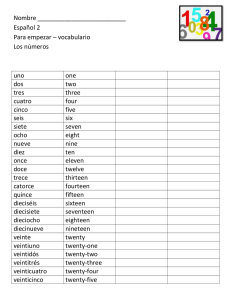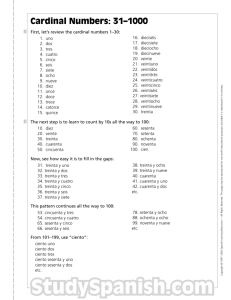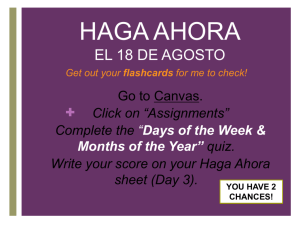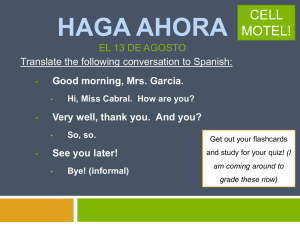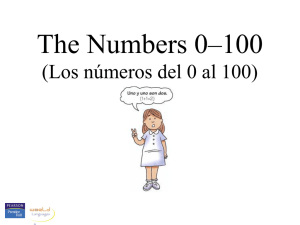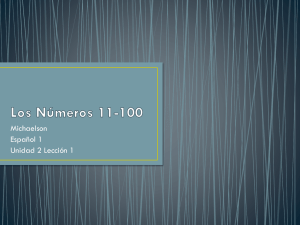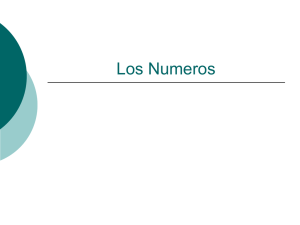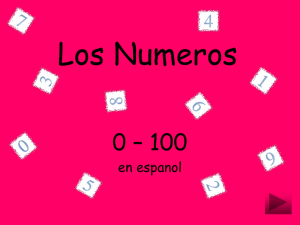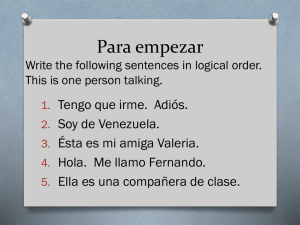ciento uno - Español con la Señorita Kennedy
advertisement
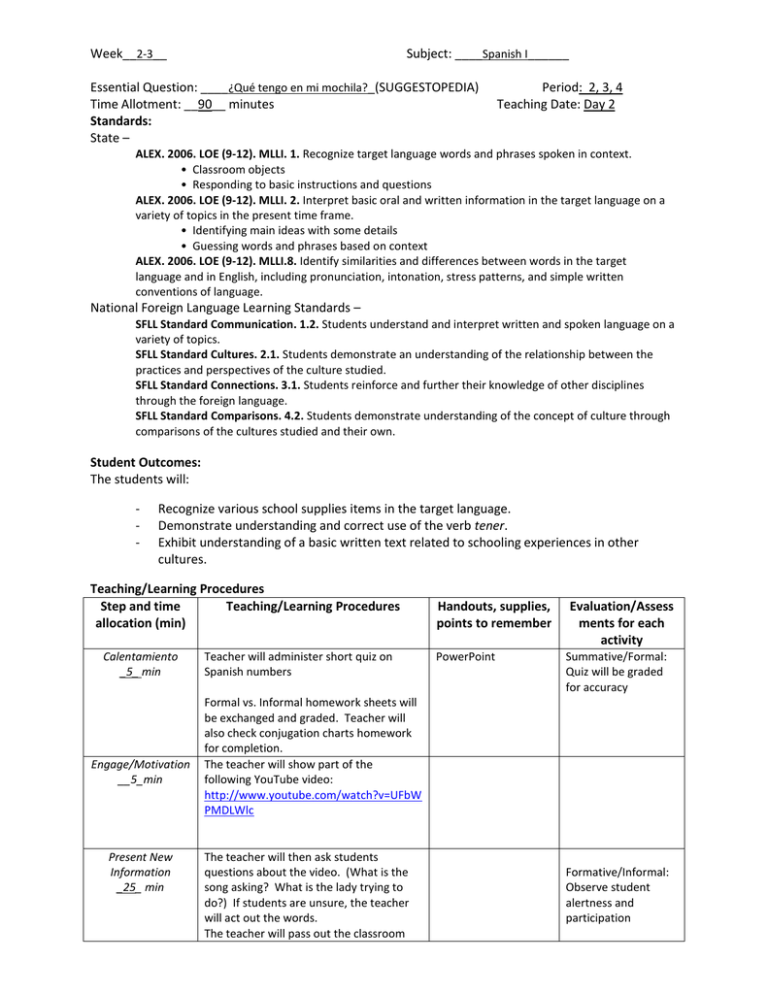
Week__2-3__ Subject: ____Spanish I______ Essential Question: ____¿Qué tengo en mi mochila?_(SUGGESTOPEDIA) Time Allotment: __90__ minutes Standards: State – Period: 2, 3, 4 Teaching Date: Day 2 ALEX. 2006. LOE (9-12). MLLI. 1. Recognize target language words and phrases spoken in context. • Classroom objects • Responding to basic instructions and questions ALEX. 2006. LOE (9-12). MLLI. 2. Interpret basic oral and written information in the target language on a variety of topics in the present time frame. • Identifying main ideas with some details • Guessing words and phrases based on context ALEX. 2006. LOE (9-12). MLLI.8. Identify similarities and differences between words in the target language and in English, including pronunciation, intonation, stress patterns, and simple written conventions of language. National Foreign Language Learning Standards – SFLL Standard Communication. 1.2. Students understand and interpret written and spoken language on a variety of topics. SFLL Standard Cultures. 2.1. Students demonstrate an understanding of the relationship between the practices and perspectives of the culture studied. SFLL Standard Connections. 3.1. Students reinforce and further their knowledge of other disciplines through the foreign language. SFLL Standard Comparisons. 4.2. Students demonstrate understanding of the concept of culture through comparisons of the cultures studied and their own. Student Outcomes: The students will: - Recognize various school supplies items in the target language. Demonstrate understanding and correct use of the verb tener. Exhibit understanding of a basic written text related to schooling experiences in other cultures. Teaching/Learning Procedures Step and time Teaching/Learning Procedures allocation (min) Calentamiento _5_ min Engage/Motivation __5_min Present New Information _25_ min Teacher will administer short quiz on Spanish numbers Handouts, supplies, points to remember PowerPoint Evaluation/Assess ments for each activity Summative/Formal: Quiz will be graded for accuracy Formal vs. Informal homework sheets will be exchanged and graded. Teacher will also check conjugation charts homework for completion. The teacher will show part of the following YouTube video: http://www.youtube.com/watch?v=UFbW PMDLWlc The teacher will then ask students questions about the video. (What is the song asking? What is the lady trying to do?) If students are unsure, the teacher will act out the words. The teacher will pass out the classroom Formative/Informal: Observe student alertness and participation items vocab list and ask students to write down the SPANISH names for as many of the words as they can, as a little more of the video is played. Classroom vocab list (part 1) State and show objectives to students PowerPoint First, the teacher will write the conjugations for the verbs tener and necesitar on the board for students to copy and then discuss. Students are to copy verb conjugations in their notes Using her own backpack full of school supplies, the teacher will use the Suggestopedia technique to go over the various vocabulary words on the lists that the students have. As the teacher talks about an item, she will place the name of that item on the screen behind her so students can correctly record the Spanish names for the items. The teacher will also show the slide with the names of the various classes on it. The teacher will then use the verbs tener and necesitar to ask students what items they have or what they may need. Students are expected to answer “Sí, tengo/…” or “No, no tengo/necesito…” This will be done with the classes as well. At the end of class, classroom vocab list will be checked for completion Ask questions to check comprehension PowerPoint slides with vocab Put up slide with conjugations Formative/Informal: Observe student alertness and participation Teacher will also include discussion about the word hay (there is/there are). Explain and Model Activity 10 min Pre-reading activity: In English, the teacher will ask students to think about that they believe should be basic rights of children around the world. Students will be encouraged to share answers. Then teacher will explain that school is not something that is guaranteed for all students all around the world. Talk about why education is important. Formative/Informal: Ask for and clarify any questions The teacher will then explain that students will be reading a short passage that will talk about these ideas and incorporate some of the new vocabulary that has been discussed. When students read, they are not expected to know every single word, but to use context clues, pictures, titles, and cognates in order to figure out what the main idea of the statement or story may be. The teacher will then ask students to look at the pictures and to scan the reading for List cognates on board as students say them cognates and main ideas. Students will be asked to underline the cognates as they are discussed. The teacher will discuss the Spanish and English acronym UNICEF Reading Activity _30 min Fondo Internacional de Emergencia de las Naciones Unidas para los Niños / United Nations International Children's Emergency Fund Students will read the short passage “La UNICEF y una convención para los ninos” silently to themselves first. Then the teacher will read the story aloud, periodically asking questions to check comprehension. Post-reading activity: The teacher will then pass out the questions for the passage, and students will be asked to work in partners to complete them. Teacher will collect the answers and send students back to their seats to finish the second part of the assignment. Students will look at the list of things that UNICEF has said that all kids need. IN ENGLISH students are to: 1) Explain whether these items are privileges or necessities. 2) Choose three items from this list and write two full sentences for each explaining what each is and why it is important to them. Closure/Preparatio n for Next Class _15_min The teacher will collect these responses and then review the answers to the comprehension questions with students. Walk among students to monitor and keep on task Summative: Students turn in completed questions and responses to children’s rights for evaluation. (If students do not finish, this must be completed for homework!!) Clarify any misunderstandings/ questions Teacher will administer numbers and classroom vocab review homework sheet to be completed by next class. Materials/Resources: Laptop/Computer connected to projector, PowerPoint, YouTube, Classroom vocabulary list (parts 1 and 2), reading passage and post-reading activity (from Realidades textbook pp. 114-115), numbers puzzle from Realidades workbook (p. 4), classroom vocabulary Cloze passage adapted from ¡En español!: Cuaderno más práctica (p. 33) Assessment/Assignments Diagnostic: Formative/Informal: Summative/Formal: Students will be expected to listen to and record the Spanish names of various classroom items and the conjugations of tener and necesitar. Furthermore, comprehension of these words and ideas will be taken a step farther to include a cultural evaluation of children’s school rights in other countries. Homework sheet and conjugation charts will be completed for accuracy. Observation of participation and comprehension checks throughout class Completed student worksheets will be evaluated for accuracy Homework: Study numbers 11-100 Homework: Calentamiento (warm-up) of the following class will be a quiz about numbers 11-100 Numbers and vocab exercises will be checked for accuracy and reviewed Accommodations/Differentiation For academic disabilities: - notes on the topic will be provided before hand - numbers quiz may be modified (spelling may not be required/counted) - scaffolded reading responses will be provided for students when necessary - grading will be more lenient on sentence construction and length For behavioral disabilities: - accommodations similar to those with academic disabilities - will be seated in close proximity to the teacher for extra monitoring For physical disabilities: - for those with visual impairments, modified reading resources and responses will be given with larger font Professional Reflection: Essential Vocabulary and Phrases: Tener Necesitar Hay Spanish numbers 0-100 Classroom and subjects vocabulary UNICEF - United Nations International Children's Emergency Fund Las preguntas de “La UNICEF y una convención para los niños” Nombre__________________________ Fecha____________ 1. Para los estudiantes de todas las naciones es fácil estar en una escuela y tener una mochila. ¿Cierto o falso? 2. ¿Cuántas oficinas regionales tiene UNIFEF? 3. ¿Qué significa la sigla UNICEF? 4. ¿Dónde está el Centro de Investigaciones? 5. La convención es para los niños de todas las naciones. ¿Cierto o falso? 6. Según la convención para los niños, ¿cuáles (what) son cuatro cosas que necesitan los niños? Los números 10-100 Revista (1-10): 1 uno 6 seis 2 dos 7 siete 3 tres 8 ocho 4 cuatro 9 nueve 5 cinco 10 diez Los números diez a cien: 10-19 20-29 30-39 diez once doce trece catorce quince dieciséis diecisiete dieciocho diecinueve veinte veintiuno veintidos veintitrés veinticuatro veinticinco veintiséis veintisiete veintiocho veintinueve treinta treinta y uno treinta y dos treinta y tres treinta y cuatro treinta y cinco treinta y seis treinta y siete treinta y ocho treinta y nueve 40-49: cuarenta, cuarenta y uno, cuarenta y dos, cuarenta y tres… 50-59: cincuenta, cincuenta y uno, cincuenta y dos, cincuenta y tres… 60-69: sesenta, sesenta y uno, sesenta y dos, sesenta y tres… 70-79: setenta, setenta y uno, setenta y dos, setenta y tres… 80-89: ochenta, ochenta y uno ochenta y dos, ochenta y tres… 90-99: noventa, noventa y uno, noventa y dos, noventa y tres… 100-109: cien, ciento uno, ciento dos, ciento tres… Las reglas: Uno becomes un before a masculine singular noun and una before a feminine singular noun. un libro (one book) una mesa (one table) In compound numbers, -uno becomes -ún before a masculine noun and -una before a feminine noun. veintiún libros veintiuna profesoras (twenty-one books) (twenty-one professors) The numbers deiciséis through diecinueve (16-19) and veintiuno through veintinueve (21-29) are generally written as one word. The condensed spelling is not used after 30! Cien is used for exactly 100 or when counting the number 100 in sequence. cien estudiantes (one hundred students) noventa y ocho, noventa y nueve, cien Ciento is used in compound numbers from 101 to 199. ciento uno / ciento diez / ciento cuarenta y cinco Quick list by tens: 10 diez 60 sesenta 20 veinte 70 setenta 30 treinta 80 ochenta 40 cuarenta 90 noventa 50 cincuenta 100 cien / ciento (101+) Nombre____________________________________________ Fecha_____________________ A. Los números NUMBERS PUZZLE B. En la clase bolígrafo mochila diccionario tarea libros calculadora cuaderno papel lápiz tecnología estudiante tengo Soy _____________ de Walker High School. En mi ____________ tengo muchas cosas para mis clases. Tengo todos mis ______________ para mis clases y un ___________ para escribir. Para la clase de matemáticas, tengo una ___________________ pequeña. Para la clase de español, (yo) ____________ un ______________ bilingüe. Mi ____________ está en un cuaderno rojo, y (yo) uso el cuaderno para hacer mi _____________ en casa. ¡Mi clase favorito es la clase de ______________, porque la tarea es fácil!
![Los numeros 31 to 100 Notes [9/18/2015]](http://s3.studylib.net/store/data/007102320_1-d9ec7d73477a8c2b94901f1e6ddd220c-300x300.png)
